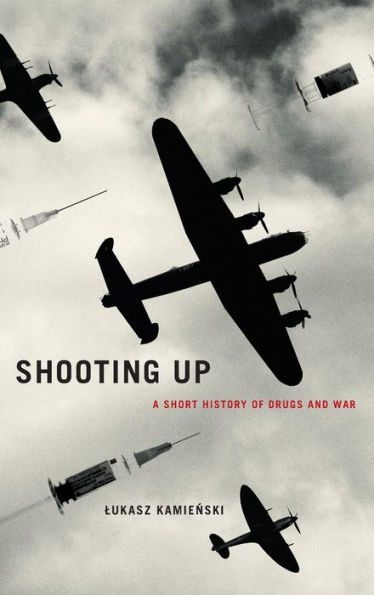Even a casual study of history reveals that drugs have been a part of human society since pretty much forever. Surprisingly (unsurprisingly?), much of the course of history has been shaped by drug use of one sort or another. Reading about the 5 examples below, it’s not hard to wonder how the world would be different if […]
5
1


Hardcover
$38.99
-
PICK UP IN STORECheck Availability at Nearby Stores
Available within 2 business hours
Related collections and offers
38.99
In Stock
Overview
Shooting Up: A Short History of Drugs and War examines how intoxicants have been put to the service of states, empires and their armies throughout history. Since the beginning of organized combat, armed forces have prescribed drugs to their members for two general purposes: to enhance performance during combat and to counter the trauma of killing and witnessing violence after it is over. Stimulants (e.g. alcohol, cocaine, and amphetamines) have been used to temporarily create better soldiers by that improving stamina, overcoming sleeplessness, eliminating fatigue, and increasing fighting spirit. Downers (e.g. alcohol, opiates, morphine, heroin, marijuana, barbiturates) have also been useful in dealing with the soldier's greatest enemy - shattered nerves. Kamienski's focuses on drugs "prescribed" by military authorities, but also documents the widespread unauthorised consumption by soldiers themselves. Combatants have always treated with various drugs and alcohol, mainly for recreational use and as a reward to themselves for enduring the constant tension of preparing for. Although not officially approved, such "self-medication" is often been quietly tolerated by commanders in so far as it did not affect combat effectiveness. This volume spans the history of combat from the use of opium, coca, and mushrooms in pre-modern warfare to the efforts of modern militaries, during the Cold War in particular, to design psychochemical offensive weapons that can be used to incapacitate rather than to kill the enemy. Along the way, Kamienski provides fascinating coverage of on the European adoption of hashish during Napolean's invasion of Egypt, opium use during the American Civil War, amphetamines in the Third Reich, and the use of narcotics to control child soldiers in the rebel militias of contemporary Africa.

Product Details
| ISBN-13: | 9780190263478 |
|---|---|
| Publisher: | Oxford University Press |
| Publication date: | 03/09/2016 |
| Pages: | 412 |
| Sales rank: | 1,156,908 |
| Product dimensions: | 6.20(w) x 9.30(h) x 1.50(d) |
About the Author
Lukasz Kamienski is Associate Professor at the Faculty of International and Political Studies, Jagiellonian University in Kraków, Poland
Table of Contents
List of TablesPreface
Concepts and Definitions: Drugs and Addiction
The Argument
The Approach
Research Questions
The Structure of This Book
Acknowledgments
Prologue
Pharmacologically Enhanced Militaries
Alcohol
An Empire Built On Rum
The Vodka Ethos
Total War in the Fog of Prohibition, Rum, and Wine
The Second World War
Alcohol and Soldiering Since 1945
Conclusion
PART ONE: FROM PREMODERN TIMES TO THE END OF THE SECOND WORLD WAR
1. Premodern Times: Opium, Hashish, Mushrooms, and Coca
Homer and a Miracle Drink Of Oblivion
The Assassins and the Archetype of the Non-Western Intoxicated Warrior and Terrorist
The Mushroom-Eaters
The Incas and Their Invigorating Coca
Coca and the Siege of La Paz
2. Napoleon in Egypt and the Adventures of Europeans with Hashish
3. The Opium Wars
A "Free Trade in Poison"
The Opium Armies
4. The American Civil War, Opium, Morphine, and the "Soldiers' Disease"
Medicine, Opium, and Morphine
The Soldier's Wounded Body
Deadly Diseases
The Salutary Opium and Morphine
The Myth of the "Soldiers' Disease"?
5. The Colonial Wars and the Terrifying "Barbarians"
The Zulus
The Moros
6. From Coca to Cocaine: The First World War
The Early Experiments with Coca and Cocaine in Europe
The Wartime Cocaine Boom
The Great War and the Cocaine Panic in Britain
7. The Second World War
The Speed
The Nazis
High Hitler
The Wehrmacht on Meth
The British
The Americans
The Japanese
The Shift in Japan's Drug Policy
The Imperial Army on Meth
The Finns: A Special Case
The Russians
Conclusion
PART TWO: THE COLD WAR
8. From the Korean War to the War Over Mind Control
The Korean War
The Controversial Korean P.O.W. Episode
9. In Search of Wonderful New Techniques and Weapons
Early American Military Experiments with Psychoactive Substances on Humans
Edgewood Arsenal: The Army's "Alchemical" Factory of Psychochemical Dreams
The Hallucinogenic Arsenal of the "Anchor of Democracy": In Search of Nonlethal Psychochemical Weapons
The Hallucinogenic Arsenal of the "Empire of Freedom": In Search of a Truth Serum
10. Vietnam: The First True Pharmacological War
Drugs "Prescribed" By the Military
Drugs "Self-Prescribed" By Soldiers
Why?
The Government Steps In
The Myth of The Addicted Army
A Painful Homecoming and "Othering" of Veterans
11. The Red Army in Afghanistan and the Problem of Drug Addiction
Soviet Vietnam
The 40th Army Heavy on Drugs
Drugs as a Weapon and Source of Funding For Military Activities
PART THREE: TOWARD THE PRESENT
12. Contemporary Irregular Armies Empowered by Drugs
13. Intoxicated Child Soldiers
The Old-New Phenomenon
The Triad of New Wars, Smaller and Lighter Arms, and Drugs
Advantages of Using Child Soldiers and the Role of Drugs
Recruitment, Training, and Building Loyalty
Enhancing Morale, Bravery, and Cruelty
Rewarding
Addiction as an Obstacle to Demobilization and Reintegration
A Challenge to Regular Armed Forces
14. Drugs in the Contemporary American Armed Forces
Speedy War and the "Violence of Speed"
Risky Combat Fatigue and Operational Sleep Deprivation
"Go Pills" And Pharmacological Management of Fatigue
Dextroamphetamine
Modafinil
Toward a New Generation of No-Go Pills?
Conclusion
Epilogue: War as a Drug
Notes
Bibliography
Index
From the B&N Reads Blog
Page 1 of
